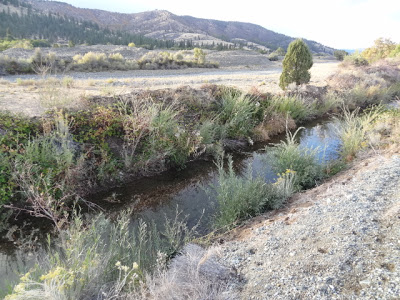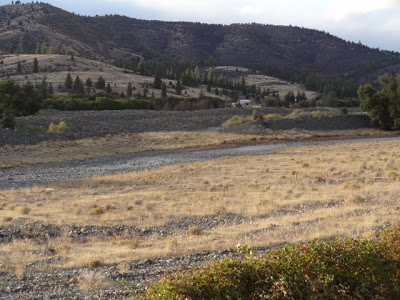Officials Said No Water Was Being Diverted From The Scott River. Evidence Suggests That's Simply Not True...
I recently posted a photograph of a stacked-up school of Klamath Chinook salmon swimming in circles while they
waited their chance to migrate up Siskiyou County's Scott River.
The Scott River was running at a bare-bones 18 cfs-22 cfs, and the Karuk and Yurok tribes had called on the US Forest Service to invoke their 40 cfs water right to protect the salmon.
The response from officials and irrigators was immediate, most suggesting there was simply no water, and that no irrigation diversions were occurring. In an email, County Supervisor Grace Bennett said that Farmer's Ditch (a sizable diversion from the Scott) was dry and had been since August 19.
That's good information. Except, unfortunately, it isn't true.
On his KlamBlog, Felice Pace
posted photographs of the Farmer's Ditch diversion running at levels far in excess of "none":
 The Farmer's Ditch Diversion (photo Felice Pace)
The Farmer's Ditch Diversion (photo Felice Pace)
His photographs were taken on October 24 (after the October 15 irrigation shutoff date), and though those using Farmer's Ditch hold a year-round livestock watering right, Pace is correct in pointing out the diversion -- which is essentially dewatering the Scott -- is far larger than needed to water livestock.
 A dewatered Scott River (photo Felice Pace)
A dewatered Scott River (photo Felice Pace)
From the Klamblog:
A large number of Chinook Salmon are in the Scott River waiting to get to their spawning grounds. However, because the Farmers Ditch is running full at an estimated 6-8 cubic feet per second 10 full days after irrigation was supposed to end under the Scott River Adjudication, the Scott River is dewatered and disconnected in the area below the Farmer's Ditch.
Unless this ditch is turned down or off soon, Chinook salmon will not be able to spawn in the Upper Scott River, the east Fork, the South Fork, Sugar Creek, Wildcat Creek and several other tributaries. Spawning and production fro the largest run in recent history will be lost. The benefit of millions of dollars the state and federal government has spent restoring habitat above the Farmer's Ditch will be rendered useless and ineffective. This is something you can and should stop.
Irrigators along the Farmers Ditch are using the pretext of a stock-watering right to continue irrigation far beyond the legal irrigation season. I have pictures showing that some of the fields being irrigated do not even have livestock in them. I also have pictures of the full ditch and the dewatered river below this diversion. I am going to send those to the press this morning along with a copy of this message to you. If you will supply me with an e-mail address that will get noticed, I'll send those pictures to you too.
Pace has long suggested that some irrigators -- who hold a livestock water right -- divert far more water than is needed and then bleed off most of it irrigating fields before delivering a tiny fraction of the water to livestock.
It's important to point out that many Scott Valley water rights holders have voluntarily stopped exercising their livestock watering rights in order to provide water for salmon (the Scott River is now running 32 cfs, up from the 18 cfs when the original photos were taken).
It's equally important to point out that a few bad actors are making a mockery of those efforts by illegally withdrawing water and endangering salmon, and that the Department of Fish && Game, the Forest Service, DWR and others have seemingly looked the other way when these abuses occur.
In fact, the whole community looks the other way (from Pace's Klamblog):
A few years ago this ditch was turned on in the Spring in a manner that dewatered the Scott River below the diversion. Several hundred thousand Salmon and Steelhead died as a result, including listed Coho Salmon. While state officials knew about this and referred the ditch manager to the DA, only a slap on the wrist resulted and the matter was not reported to or by the press. In this way, state officials and the DA countenanced lawbreaking and thereby encouraged that lawbreaking - and the dewatering of the river - to continue.
I remember the case above, and despite contacting the DA's office at the time, never received a callback or other followup.
In an email response to my earlier post about the Scott, the County's Resource Manager said that pretty much all the diversions had been shut off since October 1, and that people should talk to officials before issuing "personal diatribes" on the Scott River's situation.
I couldn't agree more, except that recent experience suggests we don't seem to get much in the way of truth from those discussions.
Meanwhile, The Scott Keeps Dropping
The Scott River and Scott Valley are a mess; flows in the river have been dropping ever since the 1980s surface water adjudication process, despite the fact that precipitation levels haven't changed (from the Kurak/Yurok tribes press release):
Before the adjudication, it was rare for flows to ever drop below 30 cubic feet per second (cfs). In fact between 1942 and 1980, the Scott dropped below 30 cfs on average only 5.6 days a year, mostly in drought years. Between 1980 and 2009, the flows dipped below 30 cfs on average 35 days a year. This year, the river has been below 30 cfs since August 3rd!
So what's drying up the Scott River? This Klamath Riverkeepers op-ed likely hits the reason on the head:
It’s also of note that precipitation patterns have not significantly changed over the years of record, so changing weather patterns are not to blame. What has changed? The number of wells drilled in Scott Valley. Prior to 1980, there were 406 wells, of which 99 were specified as irrigation wells. As of 2010, there were 790 wells in Scott Valley, 172 of which were specified as irrigation wells. Because they were drilled outside the “zone of adjudication,” these new wells are not regulated and not part of the adjudication. That is to say the existing adjudication no longer describes water use in the valley since these new wells effectively suck water out from under existing water rights holders including the Forest Service. This fact has recently been documented by a groundwater analysis by the Karuk Tribe.
It gets a little grim.
There are clearly some water users who are trying to help the salmon, though many act as if they would happily see them extirpated from the Scott (some of them contend the coho salmon aren't even native to the watershed, though we dealt with that lie here).
Layered over the top of all this are hot-button issues like private property rights, though those who assert those rights for water forget that the public holds water rights too, and that water users don't own the salmon.
This last is important, because extirpating the salmon is essentially privatizing a public resource; if you consider those salmon public property, then most of the private property rhetoric heard up here is revealed as mere posturing -- a "patriotic" excuse for a few people to siphon off a public resource for their own benefit.
See you wondering where all the water went, Tom Chandler.